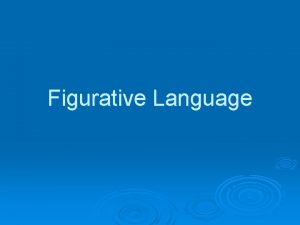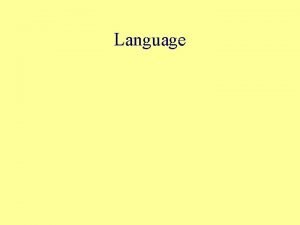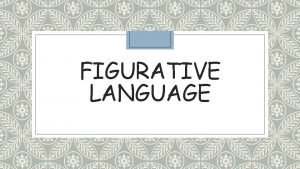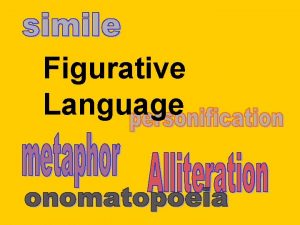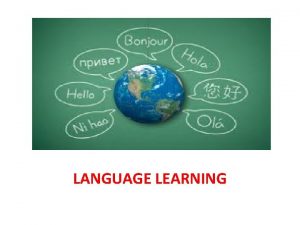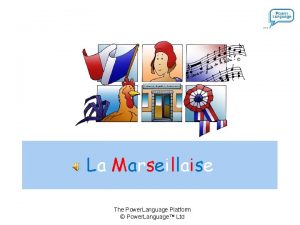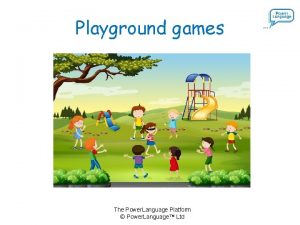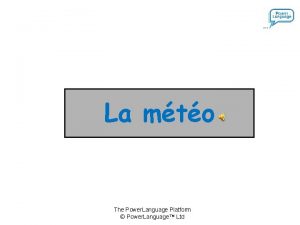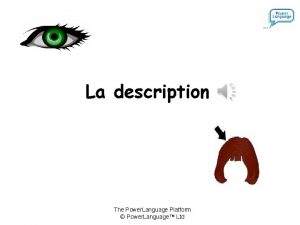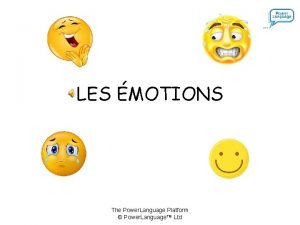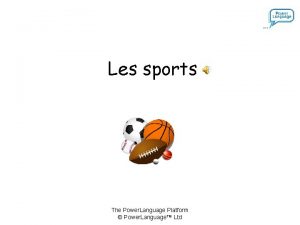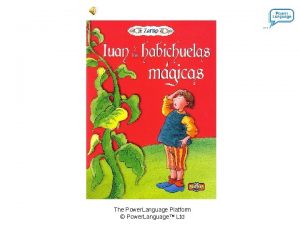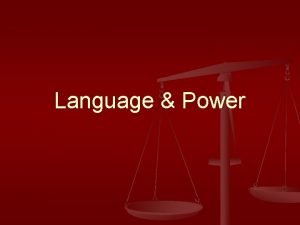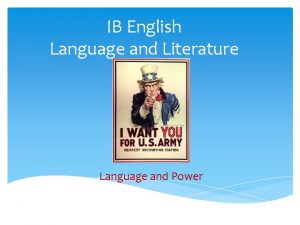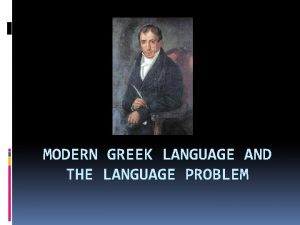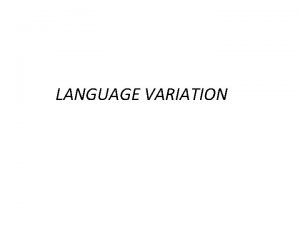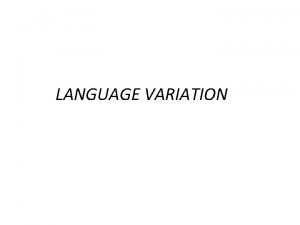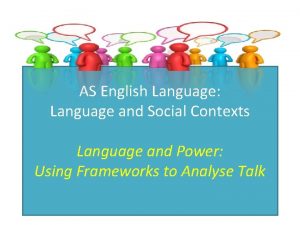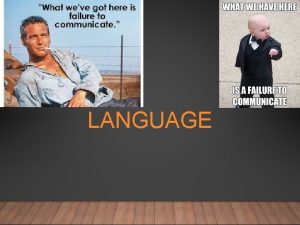Language and Power The language of power is


































- Slides: 34

Language and Power…

The language of power is found in different contexts… The purpose of political language is to persuade. To achieve this, politicians use rhetorical devices (rhetoric is the art of using language persuasively). Political 1. Rhetoric questions 2. Repetition 3. Hyperbole 4. Three-part lists 5. Figurative language 6. First person plural pronoun

Task: Read the passage below and note the rhetoric devices. n It must be said – those who betray their nation, betray themselves. They deceive, they mislead, and they lie. We must strive together for a restored nation. Under our leadership, the winter of discontent will become a summer of prosperity. How much longer must our people endure this injustice and suffering? Plague would be a better option than any policy they propose.

Legal language… 1. Legal 2. 3. Legal language is quite distinctive – it has it’s own lexis. The specific vocabulary used by an occupational group is known as jargon. The syntax is often complex, with lots of subordinate clauses. It’s also repetitive. Because it’s so complex, knowledge of this language gives specialists a distinct advantage over non-specialists. This means that lawyers have a lot of power – if their clients don’t fully understand the difficult jargon, then they have to trust that their lawyers understand it and deal with their case properly.

Sentence Structure n Simple sentences contain one clause (piece of information) and has a subject and a verb. n n Compound sentences are two simple sentences joined together with a conjunction (and, but, so). The two simple sentences must make sense on their own. n n E. g. Miss Cooper studied English Language and she also studied Literature in her first year. Complex sentences have a main clause and a subordinate clause. This basically means that they have a separate bit of the sentence that doesn’t make sense on its own. n E. g. Miss Cooper, an English teacher at St Julie’s, studied English Language at University.

Task - Identify the main and the subordinate clauses in the following complex sentences: 1. 2. 3. 4. 5. The Scarecrow and the Tin Woodman stood up in a corner and kept quiet all night, although of course they could not sleep. (L. Frank Baum, The Wonderful Wizard of Oz, 1990) Although volume upon volume is written to prove slavery a very good thing, we never hear of the man who wishes to take the good of it by being a slave himself. (Abraham Lincoln, "Fragment on Slavery, " July 1854) Because he was so small, Stuart was often hard to find around the house. (E. B. White, Stuart Little, 1945) There was a loud crack and Harry’s cloudy Patronus vanished as if he’d just run a mile, his legs shaking. (J. K. Rowling, Harry Potter and the Prince of Azkaban, 1999) Against the walls, there were eight bunks, five of them made up with blankets and the other three showing their burlap ticking. (J. Steinbeck, Of Mice and Men, 1937)

Task: Occupational Jargon – sort the following lexis into the correct categories. LEGAL • REVENUE GROWTH • BALANCE SHEETS • AGED DEBT REPORT • PROSECUTOR • ASSESSMENT • COGNITIVE ABILITY • BACCALAUREATE • PARTNERSHIP EDUCATION BUSINESS • DIFFERENTIATION • CORPORATE • CURRICULUM • CEO • QUALITY • ACADEMIC ASSURANCE • BILINGUAL • INDEMNITY • REMUNERATE • PARALEGAL • TRIBUNAL • EXCLUSION • CLAIMANT • BENEFICIARY • BEQUEST • CLIENT • REVOCATION • COST AVOIDANCE • CORE SUBJECT

Task: Occupational Jargon – sort the following lexis into the correct categories. LEGAL • • • BENEFICIARY BEQUEST CLIENT PROSECUTOR INDEMNITY PARALEGAL REVOCATION REMUNERATE TRIBUNAL CLAIMANT EDUCATION • • • ACADEMIC BILINGUAL DIFFERENTIATION ASSESSMENT COGNITIVE ABILITY CORE SUBJECT CURRICULUM BACCALAUREATE EXCLUSION BUSINESS • PARTNERSHIP • REVENUE GROWTH • BALANCE SHEETS • AGED DEBT REPORT • CORPORATE • QUALITY ASSURANCE • CEO • COST AVOIDANCE

Education… 1. Education 2. The language of power is seen in schools, colleges and universities. The language of education reflects the power structures in schools. Teachers often use imperatives – open your books and direct interrogatives – what’s the answer to question four? 3. 4. Students use fewer imperatives and ask more indirect questions – is it ok if I go to the toilet? There’s often an imbalance in address terms – students might use respectful address terms to the teacher like sir, or title + surname constructions (Ms Smith), while teachers just use the students first name. This shows an understanding that the teacher has authority.

The discourse functions of sentences… n Sentences may be classified according to their use in discourse. We recognise four main sentence functions: n n Declarative Interrogative Imperative Exclamative

Declarative Interrogative Imperative Exclamative Declarative sentences are used to convey information or to make statements. E. g. Interrogative sentences are used in asking questions. E. g. Imperative sentences are used in issuing orders or directives. E. g. Exclamative sentences are used to make exclamations: E. g. • Is this your book? • Did you receive my message? • Have you found a new job yet? • Leave your coat in the hall. • Give me your phone number. • Don't shut the door • Stop! • What a stupid man he is • How wonderful you look! • David plays the piano. • I hope you can come tomorrow. • We've forgotten the milk. ALTERNATIVE INTERROGATIVES offer two or more alternative responses: • Should I telephone you or send an email?

Sentence Structure n Simple sentences contain one clause (piece of information) and has a subject and a verb. n n Compound sentences are two simple sentences joined together with a conjunction (and, but, so). The two simple sentences must make sense on their own. n n E. g. Miss Cooper studied English Language and she also studied Literature in her first year. Complex sentences have a main clause and a subordinate clause. This basically means that they have a separate bit of the sentence that doesn’t make sense on its own. n E. g. Miss Cooper, an English teacher at St Julie’s, studied English Language at University.

Business… 1. Business 2. Power structures in the language of business are very similar to those in education – managers may speak more directly to their employees and employees may use more politeness strategies and fewer imperatives. The hierarchical structure of many businesses is shown in nouns such as subordinate, superior, team leader, and chief executive.

Wider Reading – Research Brown and Levinson’s (1987) politeness principles. Write a short summary of their findings in preparation for a test next lesson. Politeness Strategies n n n Politeness is described as a social norm, or a set of prescriptive social 'rules'. Many linguists have aimed to research politeness, including Brown and Levinson (1987), who developed their 'face theory' based on the principles of our desire to be liked and to not be imposed upon. It is first important that you understand the concept of 'face’. Face is defined as the public self-image every adult portrays, which must be attended to in interaction. There are two aspects of this face: positive and negative. n n n Positive face is the desire to be appreciated and liked. Negative face is the desire to have freedom and not to be imposed upon A Face Threatening Act (FTA) is an act which deliberately threatens the face needs of others.

Address terms show power relationships… What people call each other can reveal power relationships. As with everything, they vary in different contexts. Context… Form of address… Politics Madam/Mr Speaker, Honourable Member Law Your Honour, Ladies and Gentlemen of the jury Education Sir, Miss, Mr Briggs, Ms Briggs, Dr/Professor Business Madam chair, Sir, Madam Look out for imbalances in address terms, because they can reveal unequal power relationships.

There are different ways to exert power in a conversation… Power relationships are shown in the way people talk to each other. People assert power in different ways. 1. Initialising a conversation – this can be a means of taking the lead and establishing the topic of conversation 2. Holding the floor – this is when one speaker gives little or no opportunity for other speakers to take a turn. Usually conversation involves turn-taking, so a speaker can show dominance e. g. shut the door 3. Interrupting – some interruptions cut into the other persons turn. It shows that the person interrupting has little interest in what the speaker is saying. 4. Unresponsiveness – this is a more negative way of asserting control. If the speaking is ignored or if the back-channel noises (mm or uh huh) of the other participants are half-hearted or hesitant then the status of the speaker is undermined 5. Questioning – questions direct the topic of conversation, and make it clear when the other person is expected to talk 6. Topic changing – this can be a technique of reasserting control. Sometimes politicians do this when they may have something more positive to say, they’re trying to gain control over the direction of the conversation 7. Closing down a conversation – this asserts power by not allowing other speakers to carry on talking, e. g. saying goodbye or walking away.

Declarative Interrogative Imperative Exclamative Declarative sentences are used to convey information or to make statements. E. g. Interrogative sentences are used in asking questions. E. g. Imperative sentences are used in issuing orders or directives. E. g. Exclamative sentences are used to make exclamations: E. g. • Is this your book? • Did you receive my message? • Have you found a new job yet? • Leave your coat in the hall. • Give me your phone number. • Don't shut the door • Stop! • What a stupid man he is • How wonderful you look! • David plays the piano. • I hope you can come tomorrow. • We've forgotten the milk. ALTERNATIVE INTERROGATIVES offer two or more alternative responses: • Should I telephone you or send an email?

Context is important… It is important to pay attention to the context of a conversation when you are looking at power. 1. In a particular situation, the way power shows itself depends on how people are “positioned” in relation to each other 2. These relationships between speakers can shape the conversational strategies and type of language they use e. g. you’d expect a doctor to a patient lots of questions 3. Depending on the context of the conversation, some of the above examples of dominance can actually be interpreted as a way of showing support 4. For example, interrupting with words like yes or cutting in to repeat what the speaker has said can show that you agree and you’re listening. It doesn't’t necessarily mean that you’re trying to assert power over the person speaking 5. Similarly, asking questions can be a sign you want to control the topic of conversation, or it can be a way of passing control to somebody else to encourage them to hold the floor.

Power shows itself in different ways… The ways people exert power aren’t just about what they say. 1. Non-verbal communication (NVC) is using posture, positioning, gestures, eye contact and facial expressions to convey feelings and attitudes i. e. crossing your legs away from someone can function as a barrier and appear defensive. Maintaining eye contact longer than normal can be an attempt to assert conversation. 2. Non-verbal aspects of speech (pitch, intonation, volume, pace and stress) can also be used to assert control, e. g. when people argue they may try to dominate by shouting, raising the pitch of their voice or speaking more quickly. 3. Standard English and Received Pronunciation are the varieties of English that carry the most prestige. They’re associated with professional jobs and a good education. Because of this, speakers who use Standard English and RP are often perceived to have more authority and status than people who speak in a regional accent or dialect.

Jargon can be used to dominate… Jargon is the specialist vocabulary used in particular fields of activity, especially occupations. For example; • The medical world uses terms like adenovirus, meningococcal and septum. • Electrical engineers use terms like chrominance, phase, jitter and watchdog circuit. • Terms like these aren’t generally understood by non-specialists. 1. Jargon is often necessary when specialists are talking to other specialists – it’s a precise form of labelling objects, processes and conditions, so it means technical information can be communicated with quickly. 2. People who understand the jargon have a sense of inclusion in a group, which often brings them a higher status. 3. The problem with jargon is that when specialists use it to communicate non-specialists it can become a barrier to understanding e. g. doctors with patients, mechanics with car owners. 4. Non-specialists can feel intimidated by the specialists and excluded from the high status group. In cases like the specialists have more power and can dominate the situation. 5. Specialists can exploit this by using jargon with non-specialists in order to impress them – it makes people feel that they want to be part of the high-status group that uses such specialist terms. It can also be used to hide what’s really going on.

There alternatives to using jargon… Jargon cause real problems when it’s used inappropriately, so different measures are taken to avoid it. For example; 1. Since 1999 some of the language used in the civil courts has been changed to make it easier for non-specialists to understand 2. This includes Latin terms like in camera and subpoena which have been replaced by in private and witness summons 3. Using plainer language promotes equality, because it mean that everyone has more chance of understanding what’s being said, and specialists can’t use jargon to intimidate non-specialists. • The plain English campaign was set up in 1979 to combat the use of confusing and unnecessary jargon. • It advises organisations on how they can use plainer language. • Organisations can apply for the Crystal Mark, which shows that the Plain English Campaign has approved their documents.

Political correctness aims to promote equality… 1. Political correctness is a term to describe ways that language can be adapted to minimise social inequality 2. It’s politically correct to avoid language that insults, marginalises, or seeks to control other people or groups of people – in particular language that is sexist, ageist, and ableist (discriminates against people with disabilities) 3. Political correctness is based on the idea that language doesn’t just reflect social attitudes, but also helps to shape them. So if discriminatory is changed or avoided, then people are less likely to discriminate against others. There always reasons why terms are viewed as politically incorrect e. g.

Original term Alternative Reason Half caste Mixed race Half caste suggests less than whole, incomplete Stewardess Flight attendant Disabled person Person with disabilities

Original term Alternative Reason Half caste Mixed race Half caste suggests less than whole, incomplete Stewardess Flight attendant Stewardess reveals the persons gender. The suffix –es suggests that the male term (steward) is the original, so more important Disabled person Person with disabilities Disabled person is a dehumanising label – it characterises people by their disability. The alternative version takes the focus away from their disability

There’s a lot of debate about political correctness… n n n Arguments for political correctness Language helps to shape social attitudes. Changing it sends a clear message about what is acceptable, which encourages people to change their attitudes It acts as a symbol that society is committed to becoming more equal and inclusive It’s often blown out of proportion – people focus on outrageous examples of political correctness, when most actually have a reasonable explanation n n Arguments against political correctness People feel they’re being restricted, and can’t speak their minds without getting into trouble It’s pointless because language only reflects social attitudes, it doesn’t shape them Some feel it creates resentment towards the groups it tries to protect, so discrimination is just as likely It’s pointless because language always changes – words that were once politically correct eventually become less acceptable. For example, Third World was replaced by developing worlds, but now Majority world or less economically developed country (LEDC) is seen as more politically correct

The media holds considerable power… The language of the media can have a big influence on people’s attitudes and values. This occurs in a number of ways; 1. Bias – the tendency to take sides and view things subjectively e. g. only focussing on the positive aspect of a new law or political party, or using loaded and emotive language to present factual information e. g. tragic disaster 2. Prejudice – a preconceived opinion of a person or group that isn't based on experience or reason. Media texts can create and reinforce these negative opinions so that an audience begin to associate them with a particular groups of people e. g. describing asylum seekers as “scrounging of the taxpayer” 3. Stereotypes – simplified images or descriptions of people and events. The most common are based around gender roles, in which men are viewed in a certain way and women in another. The media can easily create and reinforce stereotypes when presenting pictures, information and opinions 4. The media can also affect an audience’s point of view by sensationalising stories (making a big deal out of them), being selective with quotes or information, or using ambiguous language.

Adverts are the most persuasive form of media… All adverts aim to attract an audience to a particular product, service or cause by focusing on the following things. 1. Selling – advert makers use different approaches to do this, e. g. showing attractive people with luxurious lifestyles using a product to persuade the audience to buy it 2. Form – written adverts come in different forms e. g. in newspapers and magazines. They can also be in the form of appeal letters that come through your door, leaflets, posters and emails (SPAM) 3. The target audience is the audience the advert is aimed at. This could be very broad (food shoppers, drivers) or more specific (boys who like snowboarding) 4. The hook is the device advertisers use to get the audience’s attention – it could be verbal, visual or musical 5. In paper-based adverts the text is referred to as copy. People who write adverts are sometimes called copywriters. It's their job to come up with many ways to make adverts interesting and grab their target audiences attention.

Adverts use a number of creative features… Adverts manipulate language just like any other persuasive text. Here a few example; • Lexis – comparative and superlative adjectives and hi-tech jargon make the product seem state-of-the-art • Grammar – imperatives without subjects are common hooks e. g. “unite, enjoy” but adverts use all kinds of sentence functions. They also use disjunctive sentences (e. g. “elegant but sturdy”) to make concise comparisons • Phonology – adverts often rely on alliteration, onomatopoeia and rhyme to make concise comparisons • Graphology – the images, colour and typeface are also carefully chosen to make the advert stand out • Discourse structure – the hook is normally followed by further persuasion or information and then instruction on how to get hold of the product e. g. price, where it’s available, how to contact the company etc.

Using puns and well known collocation also grabs the audience’s attention and sticks in their minds… • Semantic puns e. g. “fly with us, the sky’s the limit” • Phonetic puns e. g. “Hair today, gone tomorrow” • Figurative language e. g. “Is there a black hole in your pocket? Start saving now!”

Referencing other texts is called intertextuality. This create a more memorable and accessible text… • For example, a hook for a mattress advert – and on the seventh day he rested. This echoes words from the bible so a lot of people will recognise it. This is aimed at quite a general target audience. • Other adverts aim to appeal to a more specific audience. The reference texts to “stroke” the audience – they will feel knowledgeable and know that the product will only appeal to an elite few. • E. g. a hook for a luxury travel company advertising city breaks in London and Paris – A Tale of Two Cities. This references the title of a Charles Dickens novel, which not everyone would be familiar with.

Tabloid newspapers use different language to broadsheets… Every newspaper takes a slightly different political viewpoint, so their purpose is to persuade as well as to inform. Newspapers are in competition with each other, so they also need to entertain readers to keep them interested. 1. Tabloid newspapers are ones like The Sun and The News of the World. They tend to make their viewpoint on a story very clear, and use quite straightforward language 2. Broadsheets are newspapers such as The Guardian and The Daily Telegraph. They’re aimed at a professional mostly middle class readership.

Features of tabloid newspapers Features of broadsheet newspapers Short paragraphs Longer paragraphs Large font, spread out Smaller font, compact Large print, sensationalised headlines (May Day Massacre) Smaller print, factual headlines (PM defeat at poll) Lots of large photographs Fewer smaller photographs Short, Anglo-Saxon words (think, death) Long, Latinate words (cogitate, deceased) Simple sentences with few clauses Complex sentences with more subordinate clauses Simple punctuation, exclamation marks Complex punctuation, few exclamation marks First names or nicknames (Gordon or Macca) Full names or surnames (Gordon Brown, Mc. Cartney) Sensationalised news stories, on-sided point of view Fact based news stories, often more objective stance Emotive vocabulary (Monster rapist gets off with five years) Neutral vocabulary (rapist gets five year sentence) Personalisation Impersonal tone Informal vocabulary (pal, kids) More formal vocabulary (friend, children) Use of phonological features like alliteration and rhyme. Also phonetic spelling (No bovver says Becks) Fewer phonological features (no problem for Beckham) Use of puns (Santa's grotty) Few puns

Even more on newspapers… 1. Newspaper language also makes use of modifier + headword constructions 2. In the case of the tabloids this is often for sensational effect e. g. emotive modifiers such as tragic hero, incest fiend, heartbroken midfielder, chilling image 3. Broadsheets use these constructions less. When they do, they tend to be more factual, e. g. experienced manager, Dublinborn criminal.

Quick quiz… 1. 2. 3. 4. 5. 6. 7. What is prejudice? Give a linguistic example. Explain the terms; target audience hook copy Describe how adverts use lexis, grammar, phonology and graphology to appeal to their audience. Outline three main differences between tabloid and broadsheet newspapers. What is the effect of modifier + headword constructions? In what ways can jargon be seen as a positive use of language? Why do some people argue against political correctness?
 Power trianlge
Power trianlge Hát kết hợp bộ gõ cơ thể
Hát kết hợp bộ gõ cơ thể Lp html
Lp html Bổ thể
Bổ thể Tỉ lệ cơ thể trẻ em
Tỉ lệ cơ thể trẻ em Gấu đi như thế nào
Gấu đi như thế nào Tư thế worm breton là gì
Tư thế worm breton là gì Chúa sống lại
Chúa sống lại Các môn thể thao bắt đầu bằng tiếng bóng
Các môn thể thao bắt đầu bằng tiếng bóng Thế nào là hệ số cao nhất
Thế nào là hệ số cao nhất Các châu lục và đại dương trên thế giới
Các châu lục và đại dương trên thế giới Công thức tính độ biến thiên đông lượng
Công thức tính độ biến thiên đông lượng Trời xanh đây là của chúng ta thể thơ
Trời xanh đây là của chúng ta thể thơ Mật thư tọa độ 5x5
Mật thư tọa độ 5x5 101012 bằng
101012 bằng độ dài liên kết
độ dài liên kết Các châu lục và đại dương trên thế giới
Các châu lục và đại dương trên thế giới Thơ thất ngôn tứ tuyệt đường luật
Thơ thất ngôn tứ tuyệt đường luật Quá trình desamine hóa có thể tạo ra
Quá trình desamine hóa có thể tạo ra Một số thể thơ truyền thống
Một số thể thơ truyền thống Cái miệng bé xinh thế chỉ nói điều hay thôi
Cái miệng bé xinh thế chỉ nói điều hay thôi Vẽ hình chiếu vuông góc của vật thể sau
Vẽ hình chiếu vuông góc của vật thể sau Nguyên nhân của sự mỏi cơ sinh 8
Nguyên nhân của sự mỏi cơ sinh 8 đặc điểm cơ thể của người tối cổ
đặc điểm cơ thể của người tối cổ Thế nào là giọng cùng tên
Thế nào là giọng cùng tên Vẽ hình chiếu đứng bằng cạnh của vật thể
Vẽ hình chiếu đứng bằng cạnh của vật thể Vẽ hình chiếu vuông góc của vật thể sau
Vẽ hình chiếu vuông góc của vật thể sau Thẻ vin
Thẻ vin đại từ thay thế
đại từ thay thế điện thế nghỉ
điện thế nghỉ Tư thế ngồi viết
Tư thế ngồi viết Diễn thế sinh thái là
Diễn thế sinh thái là Dot
Dot Số nguyên tố là gì
Số nguyên tố là gì Tư thế ngồi viết
Tư thế ngồi viết



































